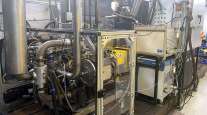Senior Reporter
Two-Truck Platoons Increasingly Realistic, NACFE Says

Commercial truck platooning is increasingly realistic, with key foundational technologies already in the marketplace and testing under way. Such an electronic tethering of two Class 8 trucks could boost both participating vehicles’ fuel efficiency by 4%, the North American Council for Freight Efficiency said in a report issued Sept. 28.
“This is an evolution, not a revolution in trucking,” Michael Roeth, NACFE’s executive director, said during a conference call with reporters to discuss the findings.
Two-truck platooning draws on adaptive cruise control and collision avoidance technologies that fleets are buying now, coupled with wireless communications, Roeth said, and should be seen as an early marker along the path to automation. “We see platooning as the next logical automation.”
QUESTIONS ON AUTONOMOUS, PLATOONING? Send them in for Oct. 4 panel, Oct. 19 LiveOnWeb
LIVEONWEB: Roeth reviewing 2015, previewing 2016
Several hurdles, however, remain to be cleared before the practice becomes common, NACFE said.
One would be increasing the driving public’s awareness on how to share the road safely with trucks that are in sync, moving at highway speeds and separated from each other by only 50 feet.
Another is educating law enforcement officers about this method of delivering freight, which at first glance would seem to violate state laws regulating how closely trucks may follow each other.
One aspect of the process now that is likely to change over time is vehicle-to-vehicle communications, NACFE said — or how key operational characteristics of each truck in a platoon are transmitted between them, including the signals needed for coordinated braking and acceleration.
So far, that is being done with dedicated short-range communications at 5.9 GHz, such as is used already in electronic toll collection and weigh-station bypass situations, NACFE said.
But other avenues are likely to open up, said Rick Mihelic, a NACFE program manager, because the industry is still very new and standards are not thoroughly defined yet.
It is likely some “innovative guys out there are possibly going to come up with some alternatives to the [DSRC] approaches, and speed [of transmission] will be a factor. We are just going to have to see where it goes in the next few years,” Mihelic said.




